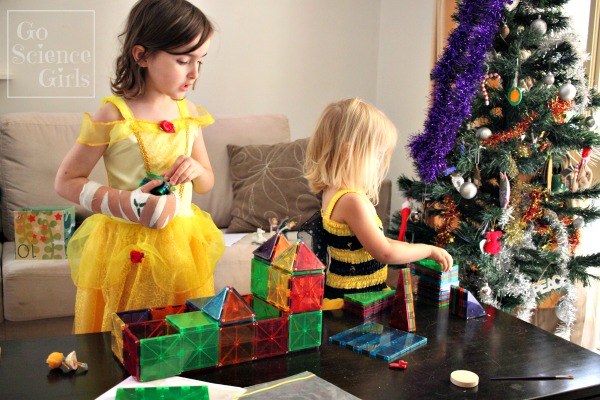
The girls were lucky enough to receive this set of Magna-Tiles from their Grandma for Christmas. They play with them almost every day. There are so many ways to play with Magna-Tiles, and we’re only just scratching the surface. But I thought I would share some of my initial reflections on how they’ve been playing with them so far, and in particular, the rich hands-on geometry that has evolved out of this play.
Usually when the girls play with their Magna-Tiles, they construct some sort of prop for imaginative play. They build trains, rockets, castles, stables, ships, school rooms and dungeons. Because the Magna-Tiles connect together really easily, they can build these structures in a few minutes, and they continue to adapt their structures (by adding or taking away pieces) as they play, so that their building is always evolving.
This, of course, provides all sorts of fantastic physics, engineering and math learning opportunities through play!
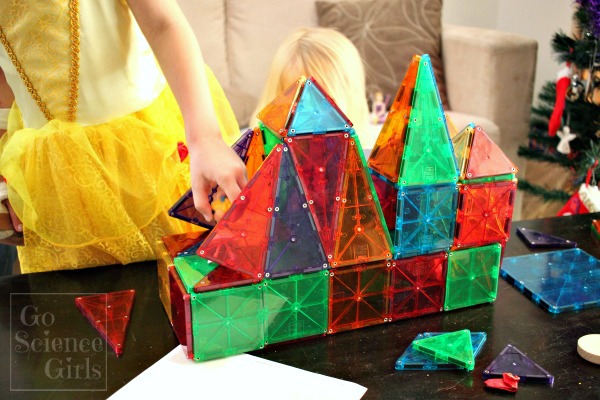
Our Magnatiles set includes small squares, large squares, equilateral triangles, isosceles triangles and right angle triangles. From the beginning, we’ve been calling these shapes by their proper names. I figure, if the girls can remember and pronounce all the names of the Disney princesses, they can easily remember the names of the different triangles too, right? (Pocahontas, Rapunzel and Aurora are not exactly easy to pronounce!)
But this post isn’t really about memorising triangle names. It’s more what the girls are learning, mostly through their own explorations, that’s really impressing me about Magna-Tiles.
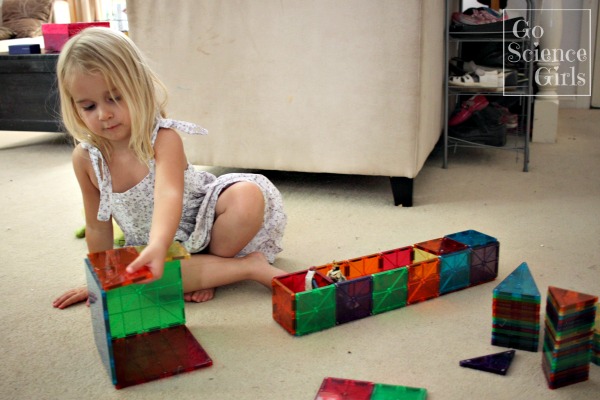
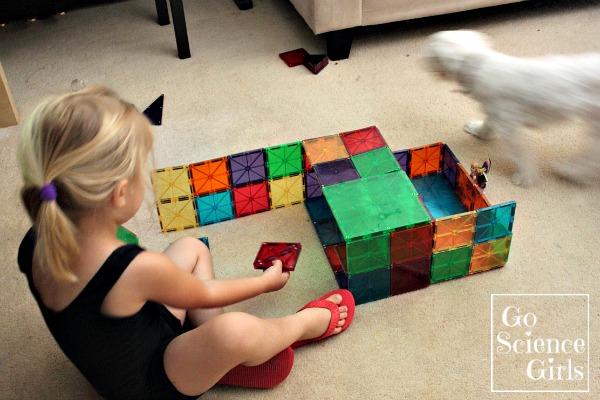
The girls are learning that if you put two (or more) squares together, you get a rectangle. If you run out of large squares, you can add four small squares together to make one. Six square sides make a cube. Another way to make a cube, is to stack squares on top of one another until they reach the right height. This makes a solid cube instead of a hollow one.

If you run out of small squares, you can make a new one by adding two right angle triangles together. And you can combine four right angle triangles together to make a different sized square altogether.
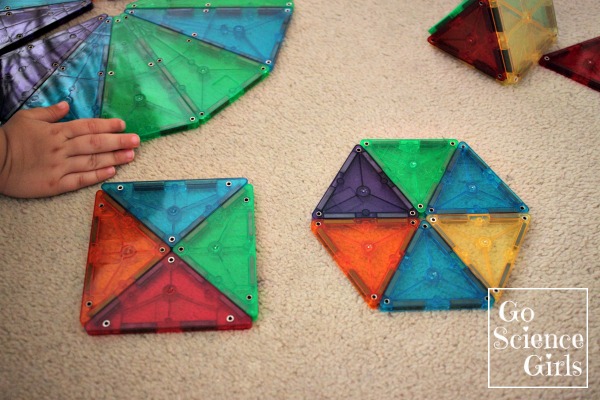
They are also learning, that you can’t make a square with the other types of triangles. Only right angle triangles work for that.
If you try adding four equilateral triangles together, it looks like 4/6 of a hexagon. (Fractions!)


Once you have your hexagon, you can add isosceles triangles to the outside to make a pretty star. If you then bring those isosceles triangles up to meet at the apex, you’ve made a hexagonal pyramid. (I told them the name for that one, but only after they’d worked out how to actually make it on their own).


So, the girls now understand that a pyramid is named after the shape that is on its base. They’ve also worked out how to make triangular and square pyramids, and they’ve worked out how to make them with different heights, depending on whether they use isosceles or equilateral triangles for the pyramid’s faces. The taller pyramids made with the isosceles triangles make cool tall spikes for the top of a rocket ship or castle tower.

I showed them how, if you happen to use only equilateral triangles for all the sides of your pyramid, it has a special (but not so special sounding) name – called a regular triangular pyramid. You can flip it over any which way, and it always lands looking the same.
There’s another shape they worked out how to make with triangles – a triangular prism. That one has only two triangles on the ends, and the other sides are squares or rectangles. Triangular prisms are great for adding a slanted roof for a house, or as little tents if you’re pretending to go camping.
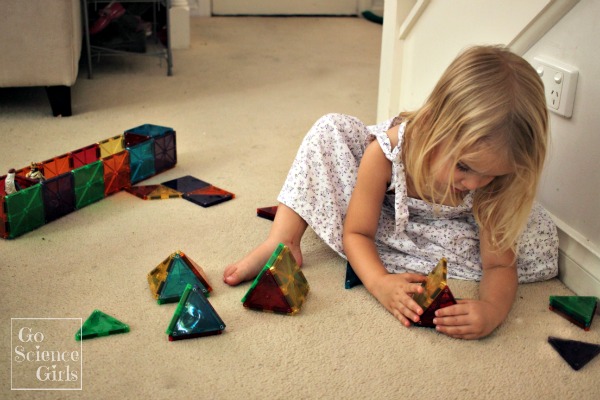
Of course, they don’t restrict themselves to making just these shapes. They make all sorts of things!
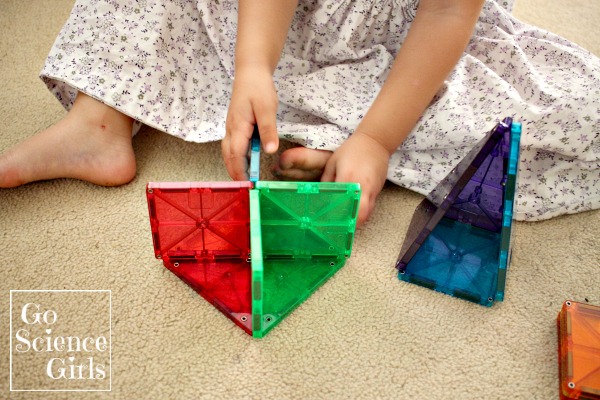
Lots of fun, hands-on STEM learning through play!
There are various size sets of Magna-Tiles to choose from – it’s one of those toys where the more pieces you have, the more ways there are to play. We have this 100 piece set, and whilst it’s ample, I’d still love more! (Especially when friends come over, and everyone wants to build something at the same time). I should also note that I’ve heard from friends that similar magnetic tiles from a different brand (I can’t remember which one) are just as good. They say their kids use both brands together and they work fine (although I haven’t tried this myself). Shop around and see how you go.
For more playful math and STEM ideas:
- Read our review of Geomag Colour and Geomag Glitter, a different type of magnetic construction toy.
- Challenge yourself to make your own 3D structures, using pipe cleaners and straws.
- Use a little math magic to find the centre of a circle, from Planet Smarty Pants
- Check out this cool Pi inspired spring tree colouring in page, from Mama Smiles
- This Pi Day Themed Pumpkin Pie Playdough idea from Left Brain Craft Brain looks like fun!
- Little Bins for Little Hands has some more Pi Day fun with circle art and Pi Lego graphing to introduce this tricky concept to little kids in a fun way.
*This is not a sponsored post. Our Magna-Tiles were received as a Christmas gift from the girls’ grandmother, and I was not obligated to write a favourable review. I have, however, included affiliate link(s) in this post, at my own discretion. An affiliate link means I may earn referral / advertising fees if you make a purchase through my link, without any extra cost to you. It helps keep this little project afloat. Thank you for your support, I really appreciate it.
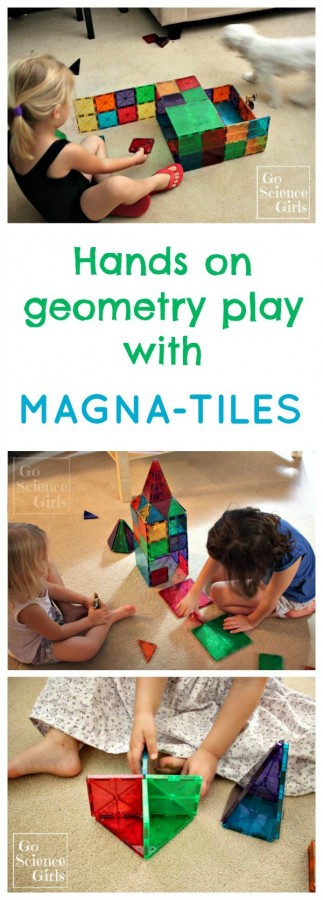

#
We just LOVE our Magna Tiles too. Best investment ever 🙂
#
Aren’t they awesome! My girls play with them practically every day…
#
#
#